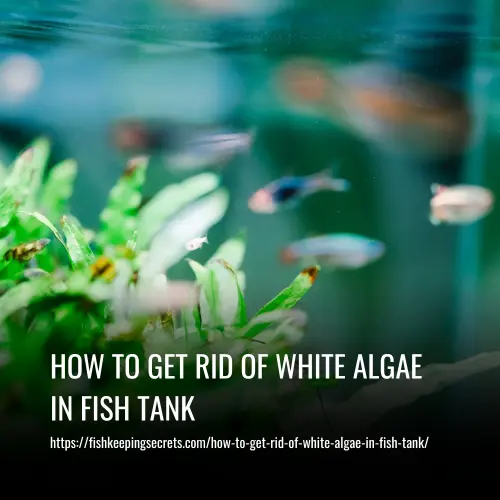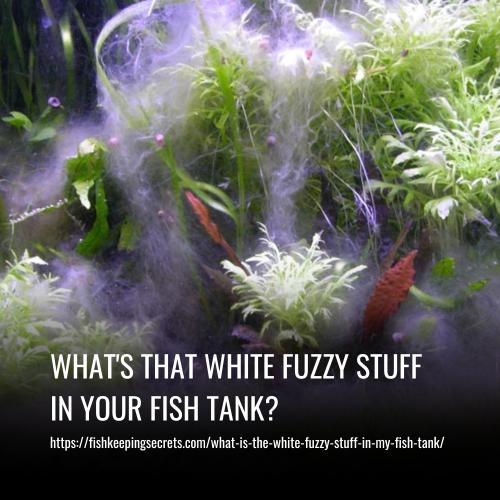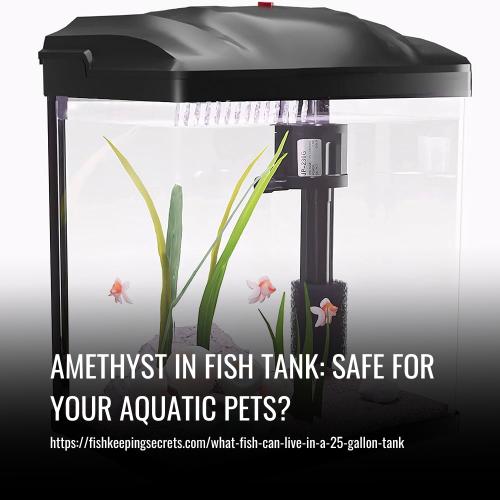White algae, also known as white fungus or aquarium mold, can be a common problem for fish tank owners. It can detract from the overall appearance of the tank and may even harm the health of your fish if left untreated. Fortunately, there are effective methods to get rid of white algae and prevent it from returning.
To get rid of white algae in fish tank, follow these steps:
- 1. Improve Water Circulation
- 2. Adjust pH Levels
- 3. Remove Excess Nutrients
- 4. Avoid Overfeeding
- 5. Decrease Light Exposure
- 6. Change the Water Regularly

How To Get Rid Of White Algae In Fish Tank
White algae can be a common problem in aquariums, but there are several ways to deal with it. Here are some tips for handling white algae:
1. Improve Water Circulation
Proper water circulation can help prevent the growth of white algae. Consider adding a water pump or adjusting the positioning of your current filter to ensure good water flow throughout the tank.
2. Adjust pH Levels
White algae tends to thrive in high pH levels. Test your water regularly and make adjustments as necessary to maintain a slightly acidic pH level, which is generally better for fish and less favorable for algae growth.
3. Remove Excess Nutrients
White algae feeds on excess nutrients in the water, such as nitrates and phosphates. Regularly clean your aquarium and remove any accumulated debris, uneaten food, or dead plants to reduce nutrient levels.
4. Avoid Overfeeding
Overfeeding your fish can lead to excess food in the water, which can contribute to algae growth. Feed your fish only the amount they can consume in a few minutes and remove any uneaten food promptly.
5. Decrease Light Exposure
White algae relies on light for photosynthesis, so reducing light exposure can help inhibit its growth. Limit the amount of light your tank receives by adjusting the duration or intensity of your aquarium lights.
6. Change the Water Regularly
Regular water changes help maintain a clean and balanced environment in your aquarium, reducing the chances of algae growth. Aim for weekly water changes of about 20-30% to keep your tank healthy.
By following these tips and maintaining a clean and well-balanced aquarium, you can effectively deal with white algae and enjoy a healthy and visually appealing fish tank.
What Are White Algae
White algae, also known as white hair algae, are photosynthetic eukaryotic organisms that grow in both freshwater and saltwater environments. They can be found in nature, fish tanks, and freshwater aquariums.
White algae form fuzzy or stringy patches on plants, grass, and aquarium items, and they have an extremely slick film. While algae are important for oxygen production, white algae can be a common sight in aquariums and may require attention to maintain a healthy environment for fish and other aquatic life.
Causes of White Algae in Fish Tanks
To prevent the development of white algae in your fish tank, it’s important to understand the causes behind their growth. The following factors contribute to the development and invasion of white algae:
1. Too High Levels of Nutrients
Maintaining proper nutrient levels in your fish tank is crucial to prevent the growth of white algae. Excess nutrients, particularly phosphates and nitrates, can fuel the growth of white algae. To prevent this, regularly measure the nutrient levels in your tank and make adjustments as necessary.
Use a high-quality filter to remove excess nutrients from the water and inhibit the development of white algae. By ensuring the right nutrient levels, you can keep your tank setup or aquarium free from white algae.
Do not overfeed fish and control the settings regularly! Check the following table for the ideal fertilizer values.
| Type of fertilizer/nutrient | Ideal quantity (mg/l) |
| CO2 | 20-35 |
| Nitrate (NO3) | 10-30 |
| Phosphate (PO4) | 0.1-1.5 |
| Potassium (K) | 10-30 |
| Iron (Fe) | 0.1-0.5 |
| Magnesium (Mg) | 5-10 |
2. Improper pH Levels
Regularly testing and controlling the pH levels in your aquarium is essential for the health of your fish. Keeping the pH level between 6.5 and 7.5 is considered ideal and helps prevent the growth of white hair algae. If the pH level goes beyond this range, it can create an environment that supports the growth of algae. By monitoring and adjusting the pH levels, you can maintain a healthy and algae-free tank.
3. Excess Light in Tanks
Excessive lighting in fish tanks can promote algae growth, including white algae. If your tank receives direct sunlight or is placed by a window, it is exposed to too much light. Algae thrives in brightly lit environments, so it’s important to limit the amount of light your tank receives. A general rule of thumb is to provide 9 hours of light per day for your fish tank. By following this rule and avoiding direct sunlight, you can help prevent the buildup of algae.
4. Overcrowding
Having too many fish and excessive decorative items in your tank can lead to increased algae growth. It’s important to avoid overcrowding and consider the size of your tank in relation to the number of pets you have. More fish means more waste in the water, providing white algae with more nutrients to thrive on. Keeping a balanced number of fish and items in your tank can help prevent algae problems.
5. Poor Water Flow
Inadequate water circulation is a major cause of white algae growth. Stagnant water pockets create an ideal environment for algae to thrive. This is particularly common in new setups, as it takes time for the water to regulate in the aquarium. To prevent this issue, it is recommended to improve water circulation and check the filtration system.
A poor or inadequate filtration system can lead to the invasion of white algae. Regularly upgrading your aquarium filter and ensuring proper water flow can help maintain a healthy environment and prevent algae growth.
By understanding these causes, you can take proactive measures to prevent the growth of white algae in your fish tank and maintain a healthy aquatic environment for your fish.
Are White Algae Harmful
White algae are not harmful to fish or other tank occupants. However, they can be unsightly and make the aquarium appear dirty. They tend to grow quickly and cover surfaces such as glass, plants, and driftwood, which can be a nuisance.
It is important to keep the aquarium clean and prevent algae invasion. If white algae have already appeared in your fish tank, there are effective ways to treat and remove them. Keep scrolling to find out how to deal with white algae.
What Eats White Algae
White hair algae can be consumed by a variety of invertebrates and aquarium fish. Here are 10 popular algae eaters that can help control the population of white algae:
- Nerite snails
- Otocinclus
- Barbs
- Malaysian trumpet snails
- Amano shrimp
- American flagship
- Siamese algae eaters
- Danios
- Sun snails
- Chinese algae eaters
It’s important to note that each of these species may prefer different types of algae, so choose one that is most effective at targeting white hair algae specifically. Additionally, make sure to select species that are compatible with your existing fish and other aquarium inhabitants.
How Long Does It Take to Get Rid of White Algae
The time it takes to get rid of white algae can vary depending on several factors. The severity of the infection, aquarium maintenance, and the size of the fish tank all play a role in determining how long it will take to eliminate the algae.
In some cases, it may only take a couple of weeks to completely remove the algae, while in others it may take several months and multiple attempts. It’s important to be patient and gather as much information as possible about white hair algae to effectively get rid of them.
How To Prevent White Algae From Growing In Fish Tank
Preventing white algae growth in your aquarium is crucial to maintaining a healthy and vibrant tank. Here are some methods you can use to prevent white algae from coming back:
1. Increase Aquarium Water Circulation
Proper water movement and circulation can help prevent the formation of long threads of white fuzz algae. Use a water pump to create better circulation and ensure oxygen and heat are distributed evenly in the tank. Additionally, addressing the main cause of white algae (high levels of organic matter) is essential.
2. Add a UV Sterilizer
Installing a UV sterilizer in your aquarium can control the growth of white algae by eliminating any floating spores. However, it does not eradicate the algae already present. Remember that excess nutrients are still the primary problem, so it’s important to address this through better filtration, adjusting feeding habits, and regular water changes.
3. Chemical Control Methods
If necessary, you can try using chemical control methods to kill off white fuzz algae. The specific medication will depend on whether the algae growth is bacterial or fungal. However, determining the type of algae growth without a microscope can be challenging. Research and consult professionals to identify the most appropriate medication for your situation. Be cautious with copper-based medicines, as they can cause issues, especially with sensitive fish species.
By implementing these preventive measures and maintaining a healthy aquarium environment, you can reduce the chances of white algae infestations and promote the overall well-being of your fish and plants.
FAQs
To get rid of white hair algae in your fish tank, it’s important to first identify the cause of the algae invasion. Once you know the cause, you can choose the best method for treating it. Some ways to eliminate white algae from fish tanks include increasing water flow, removing debris and excess nutrients, vacuuming the gravel, and upgrading your tank filter. You can also consider adding algae eaters to your tank, such as shrimp and snails, as they can help control algae growth.
No, white algae on driftwood is not dangerous. It is not harmful to fish and plants in the aquarium. You can simply use a soft brush to gently scrub the wood and remove the algae.
Fungi and white algae can look similar, which is why they are often mistaken for each other. White algae appear as white, stringy, or fuzzy patches on various surfaces. Fungi, also known as water molds, typically have a cottony growth on aquarium plants and items.
Dead algae in fish tanks can turn white, but they may also turn grey. As the algae dies, it will start to decompose and eventually detach from surfaces in the aquarium. This makes it easier to remove the dead algae and maintain a clean and healthy tank.
White algae grows over new driftwood in aquariums because the introduction of unfamiliar organics triggers the growth of beneficial bacteria. These bacteria are attracted to carbohydrates and start breaking them down, resulting in the growth of white algae fungus.
White algae growth is rare in saltwater aquariums because the organisms that cause it thrive in freshwater environments. Saltwater tanks typically use live rock and corals as decorations, which do not provide a suitable food source for white algae. Therefore, it is unlikely to see white algae growth in saltwater aquariums.
White algae in an aquarium may go away on its own when the nutrients that are fueling its growth run out. However, this can be difficult to achieve, especially if your tank has a high number of fish that produce waste and leftover food, which can contribute to the growth of white algae.
To get rid of white algae on your aquarium glass, there are a few things you can do. First, make sure your tank is getting enough light as algae thrive in low-light conditions. Increasing the light intensity can help prevent algae growth. Second, do regular water changes to remove excess nutrients that may fuel algae growth. Finally, make sure any plants in your aquarium are healthy and well-maintained as they can out-compete algae for resources.
To deal with white algae on driftwood, there are a few options you can try. One is to remove the driftwood from the tank and scrub it with a soft brush to remove the algae. However, this may damage the wood. Another option is to introduce an algae-eating fish, like a plecostomus, to control the algae growth. You can also use an antifungal or antibacterial solution on the driftwood to kill the algae and prevent future growth.
To deal with white algae on aquarium plants, there are a few steps you can take. First, ensure that the aquarium is properly lit, as too much light can encourage algae growth. Find the right balance for lighting. Second, keep the aquarium clean and free of debris by performing regular water changes and using a vacuum cleaner to remove excess nutrients that promote algae growth. Lastly, consider adding plants that are known to compete with algae for nutrients.
Yes, certain species of snails like Ramshorn snails, Nerite snails, Malaysian Trumpet snails, Mystery snails, and Mexican Turbo snails will eat white algae. They are known to be effective in controlling and grazing on white algae in both freshwater and saltwater tanks.
It is important to be able to recognize the signs of white algae growth in your aquarium. White algae typically appear as long, flowing streamers that attach themselves to various surfaces in the tank, such as rocks, decorations, plant leaves, and even the substrate. If you notice these white, stringy growths in your aquarium, it is a clear indication of white algae infestation.
Conclusion
In conclusion, dealing with white algae in a fish tank can be a frustrating experience for many fish keepers. However, by following the right steps and taking the necessary precautions, it is possible to effectively get rid of white algae and prevent it from coming back. It is important to maintain a clean and balanced environment in the tank by regularly cleaning and maintaining the water quality.
Additionally, considering the lighting, nutrients, and stocking levels in the tank can also help to prevent the growth of white algae. By staying proactive and addressing any issues promptly, fish keepers can ensure a healthy and thriving environment for their aquatic pets. With patience and diligence, anyone can successfully manage and eliminate white algae in their fish tank.



